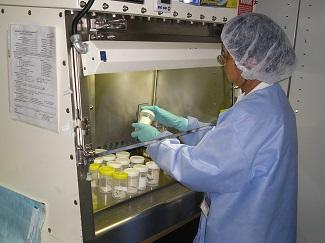Maggot Debridement Therapy in the United States
June 20, 2019
BioMonde Leaving the U.S. Market
The year 2019 began with a shadow over the field of biosurgery and a dark cloud over American health care: BioMonde, currently the largest producer of medicinal maggots in the world, just closed its American laboratory. Most famous for its dressing containing medicinal maggots within a net bag (BioBag™), BioMonde has been very profitable in Europe for years, where it operates two busy maggot-producing laboratories (in Wales and Germany). In 2014, with $5 million of dedicated investor funding,1 BioMonde opened a laboratory in Florida to serve the American market. Despite the popularity of their flagship product, BioMonde's US laboratory never turned a profit. Simply stated, sales were not high enough... but why?
Safety and Efficacy of Maggot Debridement Therapy
Medicinal maggots are widely acknowledged to be safe, effective, and relatively inexpensive wound debridement products. In published studies, maggot therapy is associated with limb salvage in 40% to 60% or more of patients scheduled for amputation.2 The chronic wound care and debridement market is quite large: Santyl (collagenase, considered by many to be the closest market competitor with medicinal maggots) is Smith & Nephew's "most significant product by sales" in their $342 million per year Advanced Wound Bioactives portfolio.3 So why is maggot debridement therapy not used as much in the United States as it is in Europe, where maggot sales are at least five times greater? Why would we continue to perform over 100,000 amputations for non-healing diabetic foot wounds,4 for example, without offering more than 2,000 of those patients that ~50% chance of limb salvage with maggot therapy? Let's examine these questions and then consider the impact and significance of BioMonde's recent retreat from the American scene. To be sure, the forces preventing the widespread use of maggot therapy in the United States do not include a lack of efficacy or safety data. The past three decades have witnessed many controlled clinical studies, as well as multiple case series and reports documenting the safety and efficacy of maggot therapy for wound debridement, compared with standard methods.2
The Yuck Factor
The yuck factor is often cited as a major impediment to the use of maggot therapy. "My patients would never agree to that," I frequently hear doctors say. Other cited memes include, "The nurses..." or "the Administration... did not go for it." Admittedly, multiple studies have demonstrated that humans consider maggots to be disgusting,5–9 but this disgust is transcultural,10 and it has not significantly prevented Europeans from enjoying the benefits of maggot therapy. My own experience, and that of many other maggot therapists, suggests that at least four out of five patients in the United States prefer maggot therapy to amputation (sorry, no citation available for this unpublished survey). Furthermore, the yuck factor should not have been much of an issue with BioMonde's BioBag product because this dressing completely contains the maggots within a net bag.11
Request for Comments on Impediments to Maggot Therapy Use
So, if squeamishness is not the most likely reason that maggot therapy is much less commonly practiced in the United States than in Europe, what is the reason? Is the prevalence of chronic wounds five times greater in Europe? Are European clinicians so unskilled in wound care that they more commonly need help from the maggots? What factors do you believe inhibit decision makers (prescribers and administrators) from choosing maggot debridement? If you considered maggot therapy but decided against it for other than clinical reasons, what were those reasons? Share your thoughts with us below. Next month, I will tell you what my research has identified as major inhibitors to prescribing maggot therapy in the United States.
References
1. Clark A. Building on an old concept in wound care. The Gainesville Sun; November 2, 2014. www.gainesville.com/news/20141102/building-on-an-old-concept-in-wound-c…. Accessed May 1, 2019.
2. Sherman RA, Mumcuoglu KY, Grassberger M, Tantawi TI. Maggot therapy. In: Grassberger M, Sherman R, Gileva O, Kim C, Mumcuoglu K, eds. Biotherapy - History, Principles and Practice. Springer, Dordrecht, Germany: Springer; 2013:5–29.
3. Smith & Nephew. Annual report 2017 (p 24). www.smith-nephew.com/global/assets/pdf/corporate/2017%20ar%20-%20intera…. Accessed May 1, 2019.
4. Centers for Disease Control and Prevention. National Diabetes Statistics Report, 2017: Estimates of Diabetes and Its Burden in the United States. Atlanta, GA: US Department of Health and Human Services; 2018. www.cdc.gov/diabetes/pdfs/data/statistics/national-diabetes-statistics-…. Accessed February 24, 2019.
5. Petherick ES, O’Meara S, Spilsbury K, Nelson EA, Torgerson DJ. Patient acceptability of larval therapy for leg ulcer treatment: a randomised survey to inform the sample size calculation of a randomised trial. BMC Med Res Methodol. 2006;6:43.
6. Schmidt CW. The Yuck factor: when disgust meets discovery. Environ Health Perspect. 2008;116:A524–A527.
7. Spilsbury K, Cullum N, Dumville J, O'Meara S, Petherick E, Thompson C. Exploring patient perceptions of larval therapy as a potential treatment for venous leg ulceration. Health Expect. 2008;11:148–159.
8. McCaughan D, Cullum N, Dumville J. Patients’ perceptions and experiences of venous leg ulceration and their attitudes to larval therapy: an in-depth qualitative study. Health Expect. 2015;18:527–541.
9. Morozov AM, Sherman RA. Survey of patients of the Tver region of Russia regarding maggots and maggot therapy. Int Wound J. 2019;16:401–405.
10. Rozin P, Fallon E. A perspective on disgust. Psychol Rev. 1987;94:23–41.
11. Sherman RA. Bagged and free-range: how different maggot therapy dressings work. WoundSource.com; August 27, 2015. www.woundsource.com/blog/bagged-and-free-range-how-different-maggot-the…. Accessed May 1, 2019. Photo provided by Ronald Sherman.
About the Author
Ronald Sherman retired from the University of California in 2008 to pursue his interests in teaching, research, and patient care. He is currently the Director of the Biotherapeutics, Education & Research Foundation, whose mission is to advance health care through education and research in biotherapy. He is also the Co-Founder and Laboratory Director of Monarch Labs, once again the sole supplier of medicinal maggots in North America. To minimize conflicts of interest, Dr. Sherman no longer provides wound care; instead he earns his living as a part-time HIV/STD physician for the Orange County Health Care Agency (health department).
The views and opinions expressed in this blog are solely those of the author, and do not represent the views of WoundSource, HMP Global, its affiliates, or subsidiary companies.












Follow WoundSource
Tweets by WoundSource